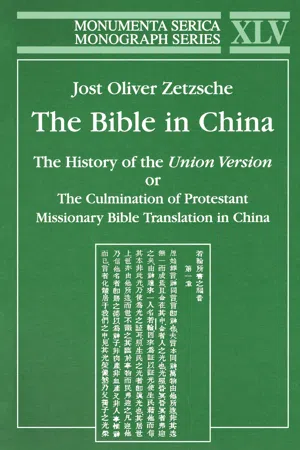![]()
1
Introduction
“And the Word became flesh, and dwelt among us”
(John 1:14)
“There is a history of translation of the Bible because there was a translation of the Word into flesh.”
(Walls 1990, 24)
The beginnings of Protestant missions in general and in China in particular are closely connected with Bible translation. The publication of William Carey’s (1761-1834) manifesto in 17921 is considered to be the starting point for the modern mission movement.2 Carey went to India the following year, and in 1799 he founded a mission in Serampore together with William Ward (1769-1823) and Joshua Marshman (1768-1834) which had its main focus on literary work. In the years from 1799 until 1832, works in more than forty languages were published by the Serampore Press, among them many biblical books, Testaments, or complete Bibles, such as the first complete Chinese Bible in 1822. Its translator, Marshman, had no Chinese language material whatsoever in the first few years of his translation work, and he relied fully in his translation on his colleague, Joannes Lassar, a young Armenian who had grown up in Macao.
In China itself, another Bible translation project was underway which was completed in 1823, one year after the Serampore translation. Its main translator was the first Protestant missionary in China, Robert Morrison (1782-1834), who today is still revered as the father of the Protestant mission in China.
Morrison had the aid of a Latin-Chinese dictionary transcript and, even more important, the transcript of an incomplete Catholic translation of the New Testament, which he used extensively for his own translation. His activities were confined to a partly secretive life in Canton with native teachers who taught him Chinese under the threat of severe punishment from their own government. Morrison thus had no concept of different styles of Chinese, of a literary and a spoken language, but he could copy and imitate the language of the Catholic New Testament translation in his possession.
He worked diligently on the compilation of language material, enabling him to publish a grammar of Chinese in 1815 and a six-volume dictionary of Chinese from 1815 through 1823, both of which would give considerable aid to later translators in the attempt to understand the different styles of Chinese. Morrison himself only slowly realized the diversity of style. He lived in Canton and was thus surrounded by the Cantonese dialect, which differed significantly from both the written language and other dialects, including the so-called Mandarin. But when he started to work on his New Testament translation—the first part of the New Testament was published three years after his arrival in China—he was not aware of the possibility of writing in any style other than classical Chinese.
“Classical Chinese” refers to the style which was used throughout Chinese literature and modeled after the canonical books, especially the Sishu and the Wujing.3 Nevertheless, it was not the only style of Chinese used in literature. Especially in the novels of the Ming and Qing dynasties,4 a less terse style of classical Chinese was employed that contained some elements of the spoken language as well, and for this reason it was often erroneously referred to as “Mandarin”. “Mandarin”5 denotes the language that was the most widely spread form of spoken Chinese in the Chinese empire, based on the language spoken in Peking. Only a small number of literary works in Mandarin were in existence at the beginning of the Protestant missionary era in China.
The question and definition of style was one of the most controversial topics in the history of Chinese Bible translation. The first generation of missionaries, who were confined in their activities to Chinese communities outside of China or to Canton and Macao, did not have sufficient knowledge of matters of style. Later missionaries learned enough about the possibilities of Chinese to define different styles as means of gaining influence on different groups of Chinese society. The classical Chinese of the classics was considered by some as a potential key to gaining influence on the literati, who were thought of as key figures in Chinese society—a concept similar to that held by the Jesuits of the 17th and 18th centuries6—whereas other translators supported a lower form of classical Chinese, or Mandarin, for Bible translation to gain access to a greater range of people—in its conception a much more genuine Protestant point of view.
This conflict was only one of the many woven into the very fabric of the history of missionary Bible translation in China. The other main points of conflict dealt with terminology, as will be especially pointed out in the translation of the two most controversial terms—“baptism” and “God”— and in a difference in the understanding of translation principles. All of these conflicts were intermingled with questions of nationalism and deno-minationalism. When the missionaries came to their mission field, they by no means disassociated themselves from the doctrinal orientation of their denominations; in fact, many saw their work in China as a great opportunity to establish their particular church in opposition and competition to other Protestant churches. Bible translation was the first and for a long time the only field of cooperation among the Protestant missionaries of different denominations, a condition which helps to explain the inevitable conflict among the missionary translators. The importance that the missionaries and the missionary societies attributed to Bible translation, and especially a common version, can be estimated by the fact that it was a major topic at three of the four general mission conferences. The first conference in Hong Kong in 1843, though usually not considered one of the major general conferences, had a common version as the only point of concern; at the general conferences in 1877 and 1907, long discussions about Bible translations were held; an...

